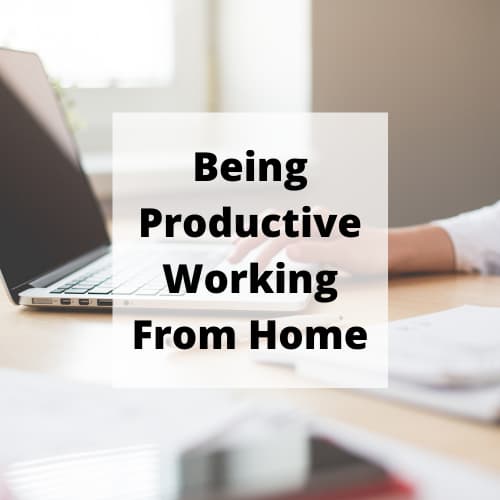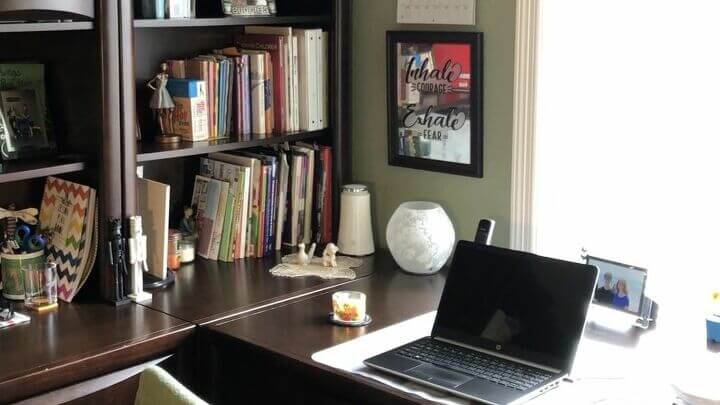Focus on Being Productive Instead of Busy Working From Home
Do you want to focus on being productive instead of busy? Being productive working from home has been a challenge, while my whole family is working and schooling together.
This post may contain affiliate links, I earn from qualifying purchases at no extra cost to you. Click here for my disclosure policy

Being Productive Instead of Busy
Whether you run a business out of your home or you are working remotely, you have more than likely struggled at some point with the distractions that being at home can bring.
Because of the ongoing COVID-19 pandemic, more people than ever are working from home. Governments all over the world are suggesting that people work from home where possible, and because of this, many of us who have never done it before is navigating the challenges – with no end in sight.
Sure, there are plenty of benefits to working from home. You can roll out of bed straight into your home office, you have reduced commuting time, you save money on travel costs and food and you can work in your pajamas if you are not on a Zoom call!
It is actually thought that in most situations, working from home can result in greater levels of productivity, with as many as nine in ten people believing that working remotely makes them work smarter and harder. Not only that, it helps people maintain that often-elusive work-life balance.
However, as we mentioned, there are some big distractions. Children never seem to understand that mom or dad needs to work in peace. The dog needs walking. That quick load of laundry needs taking out. Your neighbors think that you can take in all of their parcels. Your friend thinks you are on call for a coffee date all the time. Trying to fend off these interruptions and distractions can be hard work and really compromise your productivity, if not handled properly.
Here, we take a look at some of the things that you can do to maximize your productivity when working from home.

Get dressed
It can be tempting to literally roll out of bed and open up the laptop, telling yourself you will shower and get dressed ‘in a bit’. But before you know it, it’s lunchtime and you are still in your PJs. We aren’t saying get dressed in formal office clothes, but get up, shower, and put on something that is both comfortable and makes you feel like you can power through the day.
Make sure you have a dedicated workspace if possible
If possible is key here, because if you have suddenly been thrown into the world of remote working thanks to COVID, you may not have the space or resources to create a dedicated workspace. You might not have space even if you did plan to work from home – a dedicated space is often for the privileged few, and many people have no choice but to work from the kitchen table or balance their laptop on their lap while sitting on the couch. However, if you are fortunate to be able to create a dedicated workspace, even if it means carving out a corner of the bedroom for your stuff, do it. There are some great tips on creating a work environment mood from justaveragejen for designing and creating the perfect home office space. When you are in this space, you can focus on what you are doing and not be distracted by external factors.
Remind people you are working
When you do not physically go out to work in the daytime, many people forget that you are still working, and try to make additional demands on your time. It might be that they ask you to do some childcare or petsitting because ‘you are at home all day anyway’, or maybe they want your company and pop in for cups of coffee and a chat. Get tough with them and remind them that between the hours of X and X, you are at work and unless it is something they would approach you with if you were at the office, they are not to ask you. It is not being mean, it is making sure you remain professional and get the most out of your workdays so that you can enjoy your free time.
Split up your duties
Not even the hardest worker pursues the most difficult task 100% of the time with no respite. Managing your energies and creative potential throughout the day is the best way to stay focused and put your best work forward. That might mean designing custom stickers for your business in the morning, then working on payroll in the afternoon. Split up your duties to keep them fresh and to retain your concentration throughout your shift for the best results.
Take regular breaks
When you are working from home it can be tempting not to stop and keep going. As we mentioned above, the lack of travel time can make it easier to find a work-life balance, but this is completely wiped out if you work extra hours just because you can. If you would normally finish work at 5 pm, finish work at 5 pm. Make sure you take your lunch break and regular breaks, even if it is just grabbing a quick coffee and a breath of fresh air in your backyard.
Click here for CHAS’ HOUSE HOME TOUR VIDEO
Shop any of these stores and I receive a small commission at no cost to you.
CLICK THE IMAGE TO SEE MORE AND SHOP MY HOUSE

CLICK THE IMAGE TO SHOP MY HOME ON AMAZON

Focus on being productive instead of busy tips
- Procrastination is not your friend. Don’t put it off and don’t make an excuse. Get those important tasks done right away
- Do quality work or you’ll have to do it again
- If you have uncomfortable tasks, get help to get the day’s work done
- Learn time management and prioritization, a calendar is your friend
- Seek virtual assistants or a teammate, or team member for delegation
- Create a to-do list, and get urgent things done first
- Sometimes you can get things done in less time when you don’t use multitasking
- Map out your long-term goals
- Busy people what you can push out to the next day
- Limit your socializing
- Use noise-canceling headphones so you can focus
- Recharge at the end of the day so you’re ready to be a productive decision making machine the next day
Focus on being productive instead of busy Q & A
What to do when you feel not productive?
Feeling unproductive is a common experience that can happen to anyone from time to time. Here are some steps you can take when you’re feeling unproductive:
- Reflect on the reasons: Try to understand why you’re feeling unproductive. Is it due to lack of motivation, overwhelm, or a specific external factor? Identifying the root cause can help you address it more effectively.
- Take a break: Sometimes, taking a short break can help you recharge and regain focus. Step away from your work or task for a while, engage in a different activity, or simply relax. This can help clear your mind and increase your overall productivity when you return.
- Prioritize and set goals: Determine the most important tasks you need to accomplish and set clear, achievable goals. Break them down into smaller, manageable steps. Having a clear direction and smaller tasks to focus on can make it easier to get started and stay productive.
- Start with small wins: Tackle smaller, easier tasks first to build momentum and gain a sense of accomplishment. This can boost your motivation and productivity for more challenging tasks.
- Remove distractions: Identify and eliminate or minimize potential distractions. Turn off notifications on your phone, close unnecessary tabs or applications on your computer, and create a dedicated workspace that’s conducive to productivity.
- Break tasks into manageable chunks: Large tasks can sometimes feel overwhelming and lead to procrastination. Break them down into smaller, actionable steps, and focus on completing one step at a time. This approach makes tasks more approachable and helps you make progress consistently.
- Use productivity techniques: Experiment with different productivity techniques like the Pomodoro Technique (working in focused bursts with short breaks), time blocking (assigning specific time slots for different activities), or the Eisenhower Matrix (prioritizing tasks based on importance and urgency). Find the technique that works best for you.
- Seek accountability and support: Share your goals and progress with someone you trust, such as a friend, family member, or colleague. They can provide support, encouragement, and hold you accountable, which can increase your motivation to be productive.
- Practice self-care: Take care of your physical and mental well-being. Get enough sleep, exercise regularly, eat nutritious meals, and engage in activities you enjoy. Taking care of yourself can improve your energy levels, focus, and overall productivity.
- Review and adjust: Regularly review your productivity strategies and reflect on what works and what doesn’t. Adjust your approach as needed to find the methods that help you stay productive and motivated.
Remember, everyone has unproductive days now and then. Be kind to yourself and focus on progress rather than perfection. Celebrate small victories along the way, and don’t hesitate to seek support or guidance if needed.
What is the easiest way to practice being focused and productive instead of being busy and overwhelmed?
Practicing focus and productivity requires intentional effort and consistent habits. Here are some strategies that can help you shift from being busy and overwhelmed to being focused and productive:
- Set clear goals: Clearly define what you want to achieve and set specific, measurable, achievable, relevant, and time-bound (SMART) goals. Having a clear direction and purpose helps you stay focused and prioritize tasks effectively.
- Prioritize tasks: Identify the most important tasks that align with your goals and focus on them first. Use techniques like the Eisenhower Matrix (categorizing tasks based on urgency and importance) to determine which tasks require your immediate attention.
- Break tasks into smaller steps: Large tasks can be overwhelming and lead to procrastination. Break them down into smaller, more manageable steps. Focus on completing one step at a time, which makes tasks feel more approachable and easier to tackle.
- Practice time management: Use time management techniques to structure your workday effectively. Time blocking, where you assign specific time slots for different activities, can help you stay focused and avoid multitasking. Set realistic deadlines for yourself and use tools like timers or productivity apps to stay accountable and manage your time efficiently.
- Minimize distractions: Identify and minimize potential distractions that can hinder your focus and productivity. Turn off notifications on your phone, close unnecessary tabs or applications on your computer, and create a dedicated workspace free from distractions. Consider using website blockers or apps that limit your access to distracting websites or social media during focused work sessions.
- Embrace single-tasking: Multitasking can often lead to decreased productivity and lower quality of work. Instead, practice single-tasking by focusing on one task at a time. Give your full attention to each task, complete it, and then move on to the next. This approach helps improve focus, efficiency, and the quality of your work.
- Take regular breaks: Breaks are essential for maintaining focus and preventing burnout. Incorporate short, rejuvenating breaks into your work schedule. Use techniques like the Pomodoro Technique, where you work in focused bursts (e.g., 25 minutes) followed by short breaks (e.g., 5 minutes), to maintain productivity while ensuring regular periods of rest.
- Cultivate a productive environment: Create an environment that supports your focus and productivity. Organize your workspace, eliminate clutter, and surround yourself with tools and resources that inspire and motivate you. Consider incorporating elements like natural light, plants, or calming music, depending on what helps you concentrate.
- Practice mindfulness and meditation: Mindfulness techniques and meditation can improve your ability to focus and stay present. Dedicate a few minutes each day to practice mindfulness or meditation. This can help you train your mind to stay focused and develop greater awareness of distractions, allowing you to redirect your attention more effectively.
- Reflect and iterate: Regularly reflect on your productivity strategies and assess what works best for you. Experiment with different techniques and tools, and adjust your approach as needed. Everyone’s preferences and working styles are different, so find the methods that help you stay focused and productive.
Remember, building focus and productivity is a gradual process that requires consistency and patience. Be kind to yourself during the journey and celebrate your progress along the way.
Why am I not as productive as I used to be?
There can be various reasons why you might not be as productive as you used to be. It’s important to approach this question with self-compassion and curiosity rather than judgment. Here are some possible factors that could contribute to a decrease in productivity:
- Burnout or fatigue: Continuous periods of high stress, overwork, or lack of rest can lead to burnout or fatigue. When you’re physically and mentally exhausted, it can be challenging to maintain the same level of productivity as before. It’s crucial to prioritize self-care, take breaks, and ensure you have adequate rest to recharge.
- Lack of motivation: A decline in motivation can significantly impact productivity. If you’re feeling uninspired or disconnected from your work, it can be challenging to find the drive to be productive. Reflect on your goals, reassess your priorities, and find ways to reignite your passion or purpose.
- Overwhelm and poor time management: Feeling overwhelmed by a large workload or having difficulty managing your time effectively can hinder productivity. It’s essential to break tasks into smaller, manageable steps, prioritize effectively, and use time management techniques that work for you. Consider seeking support or guidance in developing better time management skills if needed.
- Distractions: Distractions can be a significant productivity deterrent. If you find yourself frequently interrupted by social media, email notifications, or other external factors, it can be challenging to focus and maintain productivity. Take steps to minimize distractions, such as setting boundaries, turning off notifications, or creating a dedicated workspace.
- Lack of clarity or goals: Without clear goals or a sense of direction, it’s easy to feel aimless or unsure of where to invest your time and energy. Take the time to clarify your objectives and break them down into actionable steps. Having a clear roadmap can enhance focus and productivity.
- Changes in circumstances or environment: External factors like changes in your personal life, work environment, or routines can impact productivity. It could be a new job, different responsibilities, or adjustments in your daily routine. Recognize that adaptation takes time, and it’s normal for productivity levels to fluctuate during periods of transition.
- Mental or emotional challenges: Mental health issues, stress, anxiety, or other emotional factors can have a significant impact on productivity. If you’re experiencing persistent feelings of sadness, anxiety, or difficulty concentrating, it may be helpful to seek support from a mental health professional.
- Lack of balance: If you’re neglecting other areas of your life, such as personal relationships, hobbies, or self-care, it can affect your overall well-being and productivity. Striving for a healthier work-life balance can contribute to increased productivity and overall satisfaction.
Remember that productivity levels can vary over time, and it’s normal to have fluctuations. It’s essential to approach yourself with understanding, identify potential factors contributing to the decline, and explore strategies to address them. Reflect on your current circumstances, seek support if needed, and make adjustments to regain your productivity and well-being.
What is an example of being productive?
An example of being productive can vary depending on the context and individual goals. Here’s a general example:
Let’s say you have a project deadline in two weeks. Being productive in this scenario could involve:
- Planning: Start by breaking down the project into smaller tasks and creating a timeline or schedule for completing each task.
- Prioritizing: Identify the most critical tasks that need to be done first and allocate your time and resources accordingly.
- Focus: Set aside dedicated time to work on the project without distractions. Turn off notifications, close unnecessary tabs, and create a conducive work environment.
- Taking action: Begin working on the tasks according to your schedule. Start with the highest-priority task and progress through the list.
- Time management: Efficiently manage your time by using techniques like the Pomodoro Technique (working in focused bursts with short breaks) or time blocking (assigning specific time slots for different activities).
- Problem-solving: If you encounter challenges or roadblocks during the project, instead of getting stuck, actively seek solutions. Problem-solving skills and resourcefulness are important aspects of productivity.
- Collaboration: If the project involves teamwork, actively communicate with your colleagues, delegate tasks if necessary, and coordinate efforts to ensure everyone is working effectively together.
- Continuous improvement: Regularly assess your progress, identify areas for improvement, and make adjustments as needed. Reflecting on your work can help you refine your approach and enhance productivity in future projects.
- Meeting the deadline: Ultimately, being productive means meeting your project deadline or achieving the desired outcome within the given timeframe. Successfully completing the project on time with high-quality results demonstrates productivity.
Remember, productivity is subjective and can vary depending on your specific goals and circumstances. The key is to set goals, take action, and make progress in a purposeful and efficient manner.
How do I stop being so unproductive?
To stop being unproductive, here are some actionable steps you can take:
- Identify the underlying reasons: Reflect on the possible reasons for your unproductive state. Is it due to lack of motivation, poor time management, overwhelm, or other factors? Understanding the root cause can help you address it more effectively.
- Set clear goals: Define specific, measurable, achievable, relevant, and time-bound (SMART) goals. Having clear objectives provides focus and direction, which can enhance your productivity.
- Prioritize tasks: Determine the most important tasks that align with your goals and tackle them first. Use techniques like the Eisenhower Matrix to categorize tasks based on urgency and importance. This way, you can focus your energy on the tasks that will have the most significant impact.
- Break tasks into smaller steps: Large tasks can be overwhelming and lead to procrastination. Break them down into smaller, more manageable steps. Focus on completing one step at a time, which makes tasks feel less daunting and allows you to make progress consistently.
- Manage your time effectively: Practice good time management by setting realistic deadlines, creating schedules or to-do lists, and allocating specific time blocks for different activities. Utilize productivity techniques like the Pomodoro Technique to work in focused bursts with regular breaks.
- Minimize distractions: Identify and minimize distractions that hinder your productivity. Put your phone on silent mode, close unnecessary tabs on your computer, and create a dedicated workspace free from interruptions. Consider using website blockers or productivity apps to limit access to distracting websites or social media.
- Focus on single-tasking: Multitasking can reduce productivity and quality of work. Instead, practice single-tasking by focusing on one task at a time. Give your full attention to each task, complete it, and then move on to the next.
- Take regular breaks and practice self-care: Breaks are essential for maintaining focus and preventing burnout. Incorporate short breaks into your work routine and use them to rest, rejuvenate, and recharge. Additionally, prioritize self-care activities like exercise, sufficient sleep, and relaxation to optimize your overall well-being and productivity.
- Seek accountability and support: Share your goals and progress with someone you trust, such as a friend, family member, or colleague. They can provide support, encouragement, and hold you accountable, which can boost your motivation and productivity.
- Reflect and adjust: Regularly review your productivity strategies and assess what’s working and what’s not. Be open to making adjustments and experimenting with different approaches to find what works best for you.
Remember that productivity is a journey, and it takes time and practice to develop effective habits. Be patient with yourself, celebrate small victories along the way, and stay committed to continuous improvement.
Check out some of my other posts!









